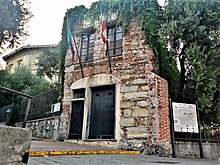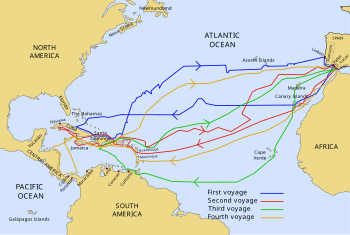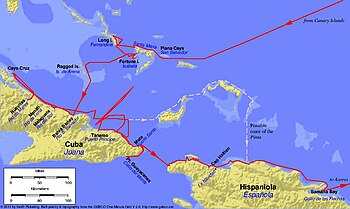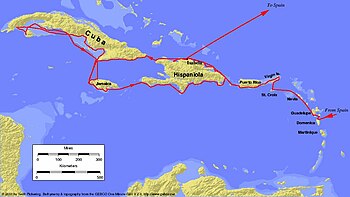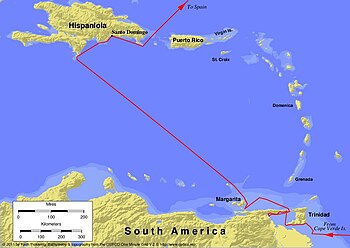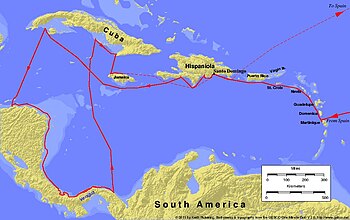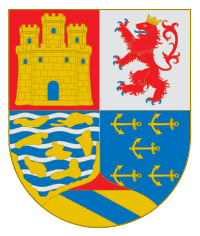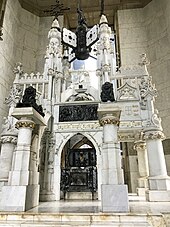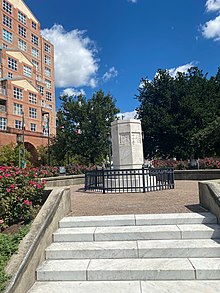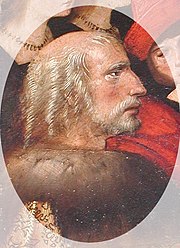Admiral of the Ocean Sea Christopher Columbus | |
|---|---|
Posthumous portrait of Columbus by Sebastiano del Piombo, 1519. There are no known authentic portraits of Columbus. | |
| 1st Governor of the Indies | |
| In office 1492–1499 | |
| Appointed by | Isabella I of Castile |
| Succeeded by | Francisco de Bobadilla |
| Personal details | |
| Born | Between 25 August and 31 October 1451 Genoa, Republic of Genoa |
| Died | 20 May 1506 (aged 54) Valladolid, Castile |
| Resting place | Seville Cathedral, Seville, Spain |
| Spouse(s) | Filipa Moniz Perestrelo |
| Domestic partner | Beatriz Enríquez de Arana |
| Children | Diego Fernando |
| Parent(s) | Domenico Colombo Susanna Fontanarossa |
| Relatives | Brothers: Giovanni Pellegrino Giacomo (also called Diego) Bartholomew Sister: Bianchinetta Columbus |
| Occupation | Maritime explorer |
| Signature | |
| Military service | |
| Rank | Admiral of the Ocean Sea |
Christopher Columbus (/kəˈlʌmbəs/; born between 25 August and 31 October 1451, died 20 May 1506) was an Italian explorer and navigator who completed four voyages across the Atlantic Ocean, opening the way for the widespread European exploration and colonization of the Americas. His expeditions, sponsored by the Catholic Monarchs of Spain, were the first European contact with the Caribbean, Central America, and South America.
The name Christopher Columbus is the Anglicisation of the Latin Christophorus Columbus. Scholars generally agree that Columbus was born in the Republic of Genoa and spoke a dialect of Ligurian as his first language. He went to sea at a young age and travelled widely, as far north as the British Isles and as far south as what is now Ghana. He married Portuguese noblewoman Filipa Moniz Perestrelo and was based in Lisbon for several years, but later took a Castilian mistress; he had one son with each woman. Largely self-educated, Columbus was widely read in geography, astronomy, and history. He formulated a plan to seek a western sea passage to the East Indies, hoping to profit from the lucrative spice trade. Following Columbus's persistent lobbying to multiple kingdoms, Catholic Monarchs Queen Isabella I and King Ferdinand II agreed to sponsor a journey west. Columbus left Castile in August 1492 with three ships and made landfall in the Americas on 12 October (ending the period of human habitation in the Americas now referred to as the pre-Columbian era). His landing place was an island in the Bahamas, known by its native inhabitants as Guanahani. Columbus subsequently visited the islands now known as Cuba and Hispaniola, establishing a colony in what is now Haiti. Columbus returned to Castile in early 1493, bringing a number of captured natives with him. Word of his voyages soon spread throughout Europe.
Columbus made three further voyages to the Americas, exploring the Lesser Antilles in 1493, Trinidad and the northern coast of South America in 1498, and the eastern coast of Central America in 1502. Many of the names he gave to geographical features—particularly islands—are still in use. He also gave the name indios ("Indians") to the indigenous peoples he encountered. The extent to which he was aware that the Americas were a wholly separate landmass is uncertain; he never clearly renounced his belief that he had reached the Far East. As a colonial governor, Columbus was accused by his contemporaries of significant brutality and was soon removed from the post. Columbus's strained relationship with the Crown of Castile and its appointed colonial administrators in America led to his arrest and removal from Hispaniola in 1500, and later to protracted litigation over the benefits that he and his heirs claimed were owed to them by the crown. Columbus's expeditions inaugurated a period of exploration, conquest, and colonization that lasted for centuries, helping create the modern Western world. The transfers between the Old World and New World that followed his first voyage are known as the Columbian exchange.
Columbus was widely venerated in the centuries after his death, but public perception has fractured in recent decades as scholars have given greater attention to the harms committed under his governance, particularly the beginning of the depopulation of Hispaniola's indigenous Taínos from mistreatment and European diseases, as well as their enslavement. Proponents of the Black Legend theory of history claim that Columbus has been unfairly maligned as part of a wider anti-Catholic sentiment. Many places in the Western Hemisphere bear his name, including the country of Colombia, the District of Columbia, and British Columbia.
Early life
Columbus's early life is obscure, but scholars believe he was born in the Republic of Genoa between 25 August and 31 October 1451. His father was Domenico Colombo, a wool weaver who worked both in Genoa and Savona and who also owned a cheese stand at which young Christopher worked as a helper. His mother was Susanna Fontanarossa. He had three brothers—Bartolomeo, Giovanni Pellegrino, and Giacomo (also called Diego), as well as a sister named Bianchinetta. His brother Bartolomeo worked in a cartography workshop in Lisbon for at least part of his adulthood.
His native language is presumed to have been a Genoese dialect although Columbus never wrote in that language. His name in the 16th-century Genoese language would have been Cristoffa Corombo (Ligurian pronunciation: [kriˈʃtɔffa kuˈɹuŋbu]). His name in Italian is Cristoforo Colombo, and in Spanish Cristóbal Colón.
In one of his writings, he says he went to sea at the age of 10. In 1470, the Columbus family moved to Savona, where Domenico took over a tavern. In the same year, Christopher was on a Genoese ship hired in the service of René of Anjou to support his attempt to conquer the Kingdom of Naples. Some modern authors have argued that he was not from Genoa but, instead, from the Aragon region of Spain or from Portugal. These competing hypotheses have generally been discounted by mainstream scholars.
In 1473, Columbus began his apprenticeship as business agent for the wealthy Spinola, Centurione, and Di Negro families of Genoa. Later, he made a trip to Chios, an Aegean island then ruled by Genoa. In May 1476, he took part in an armed convoy sent by Genoa to carry valuable cargo to northern Europe. He probably docked in Bristol, England, and Galway, Ireland. He may have also gone to Iceland in 1477. It is known that in the autumn of 1477, he sailed on a Portuguese ship from Galway to Lisbon, where he found his brother Bartolomeo, and they continued trading for the Centurione family. Columbus based himself in Lisbon from 1477 to 1485. He married Filipa Moniz Perestrelo, daughter of the Porto Santo governor and Portuguese nobleman of Lombard origin Bartolomeu Perestrello.
In 1479 or 1480, Columbus's son Diego was born. Between 1482 and 1485, Columbus traded along the coasts of West Africa, reaching the Portuguese trading post of Elmina at the Guinea coast (in present-day Ghana). Before 1484, Columbus returned to Porto Santo to find that his wife had died. He returned to Portugal to settle her estate and take his son Diego with him. He left Portugal for Castile in 1485, where he found a mistress in 1487, a 20-year-old orphan named Beatriz Enríquez de Arana.
It is likely that Beatriz met Columbus when he was in Córdoba, a gathering site of many Genoese merchants and where the court of the Catholic Monarchs was located at intervals. Beatriz, unmarried at the time, gave birth to Columbus's natural son, Fernando Columbus in July 1488, named for the monarch of Aragon. Columbus recognized the boy as his offspring. Columbus entrusted his older, legitimate son Diego to take care of Beatriz and pay the pension set aside for her following his death, but Diego was negligent in his duties.
Ambitious, Columbus eventually learned Latin, Portuguese, and Castilian. He read widely about astronomy, geography, and history, including the works of Claudius Ptolemy, Pierre Cardinal d'Ailly's Imago Mundi, the travels of Marco Polo and Sir John Mandeville, Pliny's Natural History, and Pope Pius II's Historia Rerum Ubique Gestarum. According to historian Edmund Morgan,
Columbus was not a scholarly man. Yet he studied these books, made hundreds of marginal notations in them and came out with ideas about the world that were characteristically simple and strong and sometimes wrong ...
Quest for Asia
Background
Under the Mongol Empire's hegemony over Asia and the Pax Mongolica, Europeans had long enjoyed a safe land passage, the Silk Road, to Maritime Southeast Asia, parts of East Asia, and China, which were sources of valuable goods. With the fall of Constantinople to the Ottoman Empire in 1453, the Silk Road was closed to Christian traders.
In 1470, the Florentine astronomer Paolo dal Pozzo Toscanelli suggested to King Afonso V of Portugal that sailing west across the Atlantic would be a quicker way to reach the Maluku (Spice) Islands, China, and Japan than the route around Africa, but Afonso rejected his proposal. In the 1480s, the Columbus brothers proposed a plan to reach the East Indies by sailing west. By 1481, Toscanelli had sent Columbus a map implying that a westward route to Asia was possible. Columbus's plans were complicated by the opening of the Cape Route to Asia around Africa in 1488.
Carol Delaney and others have argued that Columbus was a Christian millennialist and apocalypticist and that these beliefs motivated his quest for Asia in a variety of ways. Columbus often wrote about seeking gold in the diaries of his voyages and writes about acquiring the precious metal "in such quantity that the sovereigns... will undertake and prepare to go conquer the Holy Sepulcher" in a fulfillment of Biblical prophecy. Columbus also often wrote about converting all races to Christianity. Abbas Hamandi argues that Columbus was motivated by the hope of "[delivering] Jerusalem from Muslim hands" by "using the resources of newly discovered lands".
Geographical considerations
Despite a popular misconception to the contrary, nearly all educated Westerners understood that the Earth is spherical, a successful theory rooted in antiquity. By Columbus's time, the techniques of celestial navigation, which use the position of the Sun and the stars in the sky, had long been in use by astronomers and were beginning to be implemented by mariners.
As far back as the 3rd century BC, Eratosthenes had correctly computed the circumference of the Earth by using simple geometry and studying the shadows cast by objects at two remote locations. In the 1st century BC, Posidonius confirmed Eratosthenes's results by comparing stellar observations at two separate locations. These measurements were widely known among scholars, but Ptolemy's use of the smaller, old-fashioned units of distance led Columbus to underestimate the size of the Earth by about a third.
From Pierre d'Ailly's Imago Mundi (1410), Columbus learned of Alfraganus's estimate that a degree of latitude (or a degree of longitude along the equator) spanned 562⁄3 Arabic miles (equivalent to 66.2 nautical miles or 122.6 kilometres), but he did not realize that this was expressed in the Arabic mile (about 1,830 meters) rather than the shorter Roman mile (about 1,480 meters) with which he was familiar. Columbus therefore estimated the size of the Earth to be about 75% of Eratosthenes's calculation, and the distance from the Canary Islands to Japan as 2,400 nautical miles (about 23% of the real figure).
Furthermore, most scholars accepted Ptolemy's estimate that Eurasia spanned 180° longitude, rather than the actual 130° (to the Chinese mainland) or 150° (to Japan at the latitude of Spain). Columbus, for his part, believed an even higher estimate, leaving a smaller percentage for water. In d'Ailly's Imago Mundi, Columbus read Marinus of Tyre's estimate that the longitudinal span of Eurasia was 225°. Some have suggested he followed the statement in 2 Esdras (6:42) that "six parts [of the globe] are habitable and the seventh is covered with water." He was also aware of Marco Polo's claim that Japan (which he called "Cipangu") was some 2,414 kilometres (1,500 mi) to the east of China ("Cathay"), and closer to the equator than it is. He was influenced by Toscanelli's idea that there were inhabited islands even farther to the east than Japan, including the mythical Antillia, which he thought might lie not much farther to the west than the Azores.
Columbus therefore would have estimated the distance from the Canary Islands west to Japan to be about 9,800 kilometres (5,300 nmi) or 3,700 kilometres (2,000 nmi), depending on which estimate he used for Eurasia's longitudinal span. The true figure is now known to be vastly larger: about 20,000 kilometres (11,000 nmi). No ship in the 15th century could have carried enough food and fresh water for such a long voyage, and the dangers involved in navigating through the uncharted ocean would have been formidable. Most European navigators reasonably concluded that a westward voyage from Europe to Asia was unfeasible. The Catholic Monarchs, however, having completed the Reconquista, an expensive war in the Iberian Peninsula, were eager to obtain a competitive edge over other European countries in the quest for trade with the Indies. Columbus's project, though far-fetched, held the promise of such an advantage.
Nautical considerations
Though Columbus was wrong about the number of degrees of longitude that separated Europe from the Far East and about the distance that each degree represented, he did utilize the trade winds, which would prove to be the key to his successful navigation of the Atlantic Ocean. He planned to first sail to the Canary Islands before continuing west by utilizing the northeast trade wind. Part of the return to Spain would require traveling against the wind using an arduous sailing technique called beating, during which almost no progress can be made. To effectively make the return voyage, Columbus would need to follow the curving trade winds northeastward to the middle latitudes of the North Atlantic, where he would be able to catch the "westerlies" that blow eastward to the coast of Western Europe.
The navigational technique for travel in the Atlantic appears to have been exploited first by the Portuguese, who referred to it as the volta do mar ('turn of the sea'). Columbus's knowledge of the Atlantic wind patterns was imperfect at the time of his first voyage. By sailing due west from the Canary Islands during hurricane season, skirting the so-called horse latitudes of the mid-Atlantic, Columbus risked both being becalmed and running into a tropical cyclone, both of which he avoided by chance.
Quest for financial support for a voyage
By about 1484, Columbus proposed his planned voyage to King John II of Portugal. The king submitted Columbus's proposal to his experts, who rejected it on the correct belief that Columbus's estimate for a voyage of 2,400 nautical miles was only a quarter of what it should have been. In 1488, Columbus again appealed to the court of Portugal, resulting in John II again inviting him for an audience. That meeting also proved unsuccessful, in part because not long afterwards Bartolomeu Dias returned to Portugal with news of his successful rounding of the southern tip of Africa (near the Cape of Good Hope).
Columbus sought an audience from the monarchs Ferdinand II of Aragon and Isabella I of Castile, who had united several kingdoms in the Iberian Peninsula by marrying and were ruling together. On 1 May 1486, permission having been granted, Columbus presented his plans to Queen Isabella, who, in turn, referred it to a committee. The savants of Spain, like their counterparts in Portugal, replied that Columbus had grossly underestimated the distance to Asia. They pronounced the idea impractical and advised the Catholic Monarchs to pass on the proposed venture. To keep Columbus from taking his ideas elsewhere, and perhaps to keep their options open, the sovereigns gave him an allowance, totaling about 14,000 maravedis for the year, or about the annual salary of a sailor. In May 1489, the queen sent him another 10,000 maravedis, and the same year the monarchs furnished him with a letter ordering all cities and towns under their domain to provide him food and lodging at no cost.
Columbus also dispatched his brother Bartholomew to the court of Henry VII of England to inquire whether the English crown might sponsor his expedition, but he was captured by pirates in the process, and only arrived in early 1491. By that time, Columbus had retreated to La Rábida Friary, where the Spanish crown sent him 20,000 maravedis to buy new clothes and instructions to return to the Spanish court for renewed discussions.
Agreement with the Spanish crown
Columbus waited at King Ferdinand's camp until Ferdinand and Isabella conquered Granada, the last Muslim stronghold on the Iberian Peninsula, in January 1492. A council led by Isabella's confessor, Hernando de Talavera, found Columbus's proposal to reach the Indies implausible. Columbus had left for France when Ferdinand intervened, first sending Talavera and Bishop Diego Deza to appeal to the queen. Isabella was finally convinced by the king's clerk Luis de Santángel, who argued that Columbus would bring his ideas elsewhere, and offered to help arrange the funding. Isabella then sent a royal guard to fetch Columbus, who had travelled several kilometers toward Córdoba.
In the April 1492 "Capitulations of Santa Fe", King Ferdinand and Queen Isabella promised Columbus that if he succeeded he would be given the rank of Admiral of the Ocean Sea and appointed Viceroy and Governor of all the new lands he could claim for Spain. He had the right to nominate three persons, from whom the sovereigns would choose one, for any office in the new lands. He would be entitled to 10 percent of all the revenues from the new lands in perpetuity. Additionally, he would also have the option of buying one-eighth interest in any commercial venture with the new lands and receive one-eighth of the profits.
In 1500, during his third voyage to the Americas, Columbus was arrested and dismissed from his posts. He and his sons, Diego and Fernando, then conducted a lengthy series of court cases against the Castilian crown, known as the pleitos colombinos, alleging that the Crown had illegally reneged on its contractual obligations to Columbus and his heirs. The Columbus family had some success in their first litigation, as a judgment of 1511 confirmed Diego's position as viceroy but reduced his powers. Diego resumed litigation in 1512, which lasted until 1536, and further disputes continued until 1790.
Voyages
Between 1492 and 1504, Columbus completed four round-trip voyages between Spain and the Americas, each voyage being sponsored by the Crown of Castile. On his first voyage, he independently discovered the Americas. These voyages marked the beginning of the European exploration and colonization of the Americas, as well as the Columbian exchange, and are thus important to the Age of Discovery, Western history, and human history writ large.
Columbus always insisted, in the face of mounting evidence to the contrary, that the lands that he visited during those voyages were part of the Asian continent, as previously described by Marco Polo and other European travelers. Columbus's refusal to acknowledge that the lands he had visited and claimed for Spain were not part of Asia might explain, in part, why the American continent was named after the Florentine explorer Amerigo Vespucci—who received credit for recognizing it as a "New World"—and not after Columbus.
First voyage (1492–1493)
On the evening of 3 August 1492, Columbus departed from Palos de la Frontera with three ships. The largest was a carrack, the Santa María, owned and captained by Juan de la Cosa, and under Columbus's direct command. The other two were smaller caravels, the Pinta and the Niña, piloted by the Pinzón brothers. Columbus first sailed to the Canary Islands. There he restocked provisions and made repairs then departed from San Sebastián de La Gomera on 6 September, for what turned out to be a five-week voyage across the ocean.
On 7 October, the crew spotted "[i]mmense flocks of birds". On 11 October, Columbus changed the fleet's course to due west, and sailed through the night, believing land was soon to be found. At around 02:00 the following morning, a lookout on the Pinta, Rodrigo de Triana, spotted land. The captain of the Pinta, Martín Alonso Pinzón, verified the sight of land and alerted Columbus. Columbus later maintained that he had already seen a light on the land a few hours earlier, thereby claiming for himself the lifetime pension promised by Ferdinand and Isabella to the first person to sight land. Columbus called this island (in what is now the Bahamas) San Salvador (meaning "Holy Savior"); the natives called it Guanahani. Christopher Columbus's journal entry of 12 October 1492 states:
Many of the men I have seen have scars on their bodies, and when I made signs to them to find out how this happened, they indicated that people from other nearby islands come to San Salvador to capture them; they defend themselves the best they can. I believe that people from the mainland come here to take them as slaves. They ought to make good and skilled servants, for they repeat very quickly whatever we say to them. I think they can very easily be made Christians, for they seem to have no religion. If it pleases our Lord, I will take six of them to Your Highnesses when I depart, in order that they may learn our language.
Columbus called the inhabitants of the lands that he visited Los Indios (Spanish for "Indians"). He initially encountered the Lucayan, Taíno, and Arawak peoples. Noting their gold ear ornaments, Columbus took some of the Arawaks prisoner and insisted that they guide him to the source of the gold. Columbus noted that their primitive weapons and military tactics made the natives susceptible to easy conquest, writing, "these people are very simple in war-like matters ... I could conquer the whole of them with 50 men, and govern them as I pleased."
Columbus also explored the northeast coast of Cuba, where he landed on 28 October. On 22 November, Martín Alonso Pinzón took the Pinta on an unauthorized expedition in search of an island called "Babeque" or "Baneque", which the natives had told him was rich in gold. Columbus, for his part, continued to the northern coast of Hispaniola, where he landed on 5 December. There, the Santa María ran aground on Christmas Day 1492 and had to be abandoned. The wreck was used as a target for cannon fire to impress the native peoples. Columbus was received by the native cacique Guacanagari, who gave him permission to leave some of his men behind. Columbus left 39 men, including the interpreter Luis de Torres, and founded the settlement of La Navidad, in present-day Haiti. Columbus took more natives prisoner and continued his exploration. He kept sailing along the northern coast of Hispaniola with a single ship, until he encountered Pinzón and the Pinta on 6 January.
On 13 January 1493, Columbus made his last stop of this voyage in the Americas, in the Bay of Rincón in northeast Hispaniola. There he encountered the Ciguayos, the only natives who offered violent resistance during this voyage. The Ciguayos refused to trade the amount of bows and arrows that Columbus desired; in the ensuing clash one Ciguayo was stabbed in the buttocks and another wounded with an arrow in his chest. Because of these events, Columbus called the inlet the Bay of Arrows.
Columbus headed for Spain on the Niña, but a storm separated him from the Pinta, and forced the Niña to stop at the island of Santa Maria in the Azores. Half of his crew went ashore to say prayers in a chapel to give thanks for having survived the storm. But while praying, they were imprisoned by the governor of the island, ostensibly on suspicion of being pirates. After a two-day standoff, the prisoners were released, and Columbus again set sail for Spain.
Another storm forced Columbus into the port at Lisbon. From there he went to Vale do Paraíso north of Lisbon to meet King John II of Portugal, who told Columbus that he believed the voyage to be in violation of the 1479 Treaty of Alcáçovas. After spending more than a week in Portugal, Columbus set sail for Spain. Returning on 15 March 1493, he was given a warm welcome by the monarchs.
Columbus's letter on the first voyage, was instrumental in spreading the news throughout Europe about his voyage. Almost immediately after his arrival in Spain, printed versions began to appear. Word of his voyage rapidly spread throughout Europe. Most people initially believed that he had reached Asia. The Bulls of Donation, three papal bulls of Pope Alexander VI delivered in 1493 purported to grant overseas territories to Portugal and the Catholic Monarchs of Spain. They were replaced by the Treaty of Tordesillas of 1494.
Second voyage (1493–1496)
On 24 September 1493, Columbus sailed from Cádiz with 17 ships, and supplies to establish permanent colonies in the Americas. He sailed with 1,200 men, including priests, farmers, and soldiers. The fleet stopped at the Canary Islands, continuing three weeks later on a more southerly course than on the first voyage.
On 3 November, they arrived in the Windward Islands and landed at Marie-Galante, now part of Guadeloupe. These islands were named by Columbus on this voyage, as well as Montserrat, Antigua, Saint Martin, the Virgin Islands, and many others.
On 22 November, Columbus returned to Hispaniola to visit La Navidad, where 39 Spaniards had been left during the first voyage. Columbus found the fort in ruins, destroyed by the Taínos after some of the Spaniards had formed a murderous gang in pursuit of gold and women. Columbus then established a poorly located and short-lived settlement, La Isabela, in the present-day Dominican Republic.
From April to August 1494, Columbus explored Cuba and Jamaica, then returned to Hispaniola. By the end of 1494, disease and famine had killed two-thirds of the Spanish settlers. Columbus implemented encomienda, a Spanish labor system that rewarded conquerors with the labor of conquered non-Christian people. Columbus executed Spanish colonists for minor crimes, and used dismemberment as punishment. Columbus and the colonists enslaved the indigenous people, including children. Natives were beaten, raped, and tortured for the location of imagined gold. Thousands committed suicide rather than face the oppression.
In February 1495, Columbus took over 1,500 Arawaks, some of whom had rebelled. About 500 of them were shipped to Spain as slaves, with about 40% dying en route.
In June 1495, the Spanish crown sent ships and supplies to Hispaniola. In October, Florentine merchant Gianotto Berardi received almost 40,000 maravedís worth of slaves.
On 10 March 1496, having been away about 30 months, the fleet departed La Isabela, landing in Portugal on 8 June.
Third voyage (1498–1500)
On 30 May 1498, Columbus left with six ships from Sanlúcar, Spain. Three of the ships headed directly for Hispaniola with much-needed supplies. Columbus took the other three to continue the search for a passage to continental Asia.
On 31 July they sighted Trinidad. On 1 August, they arrived near the mouth of South America's Orinoco river. Columbus recognized that it must be the continent's mainland. On 5 August, they landed on the mainland of South America at the Paria Peninsula. They then sailed to the islands of Chacachacare and Margarita (reaching the latter on 14 August), and sighted Tobago and Grenada.
On 19 August, Columbus returned to Hispaniola. There he found settlers in rebellion against his rule, and his promises of riches. Columbus had some of the Europeans tried for their disobedience; at least one rebel leader was hanged.
In October 1499, Columbus sent two ships to Spain, asking the Court of Spain to appoint a royal commissioner to help him govern. By this time, accusations of tyranny and incompetence on the part of Columbus had also reached the Court. The sovereigns replaced Columbus with Francisco de Bobadilla, a member of the Order of Calatrava, who was tasked with investigating the accusations of brutality made against Columbus. Arriving in Santo Domingo while Columbus was away, Bobadilla was immediately met with complaints about all three Columbus brothers. Bobadilla reported to Spain that Columbus regularly used torture and mutilation to govern Hispaniola.
According to the report, Columbus once punished a man found guilty of stealing corn by having his ears and nose cut off and then selling him into slavery. Testimony recorded in the report stated that Columbus congratulated his brother Bartolomeo on "defending the family" when the latter ordered a woman paraded naked through the streets and then had her tongue cut out for suggesting that Columbus was of lowly birth. The document also describes how Columbus put down native unrest and revolt: he first ordered a brutal crackdown in which many natives were killed, and then paraded their dismembered bodies through the streets in an attempt to discourage further rebellion.
In early October 1500, Columbus and Diego presented themselves to Bobadilla, and were put in chains aboard La Gorda, Columbus's own ship. They were returned to Spain, and lingered in jail for six weeks before King Ferdinand ordered their release. Not long after, the king and queen summoned the Columbus brothers to the Alhambra palace in Granada. There, the royal couple heard the brothers' pleas; restored their freedom and wealth; and, after much persuasion, agreed to fund Columbus's fourth voyage. However, Nicolás de Ovando was to be the new governor of the West Indies.
Fourth voyage (1502–1504)
On 11 May 1502 Columbus, with his brother and son, left Cadiz with his flagship Santa María and three other vessels. He sailed to Arzila on the Moroccan coast to rescue Portuguese soldiers said to be besieged by the Moors.
On 15 June, they arrived at Martinique. A hurricane was brewing, so he continued on, hoping to find shelter on Hispaniola. He arrived at Santo Domingo on 29 June, but was denied port, and the new governor refused to listen to his storm prediction. Instead, while Columbus's ships sheltered at the mouth of the Rio Jaina, the first Spanish treasure fleet sailed into the hurricane. Columbus's ships survived with only minor damage, while 29 of the 30 ships in the governor's fleet were lost along with 500 lives (including that of Francisco de Bobadilla) and over US$10 million of Columbus's gold. A fragile ship carrying Columbus's personal belongings was the sole vessel to reach Spain.
After a brief stop at Jamaica, Columbus sailed to Central America, arriving at the coast of Honduras on 30 July. Here Bartolomeo found native merchants and a large canoe. On 14 August, he landed on the continental mainland at Puerto Castilla, Honduras. He spent two months exploring the coasts of Honduras, Nicaragua, and Costa Rica, before arriving in Almirante, Bocas del Toro in Panama on 16 October.
In Panama, Columbus learned from the Ngobe of gold and a strait to another ocean. In January 1503, he established a garrison at the mouth of the Belén River. Columbus left for Hispaniola on 16 April. On 10 May he sighted the Cayman Islands, naming them "Las Tortugas" after the numerous sea turtles there. His ships sustained damage in a storm off the coast of Cuba. Unable to travel farther, on 25 June 1503 they were beached in Saint Ann Parish, Jamaica.
For one year Columbus and his men remained stranded on Jamaica. A Spaniard, Diego Méndez, and some natives paddled a canoe to get help from Hispaniola. The governor, Nicolás de Ovando y Cáceres, detested Columbus and obstructed all efforts to rescue him and his men. In the meantime Columbus, in a desperate effort to induce the natives to continue provisioning him and his hungry men, won their favor by predicting a lunar eclipse for 29 February 1504, using Abraham Zacuto's astronomical charts. Help finally arrived, no thanks to the governor, on 29 June 1504, and Columbus and his men arrived in Sanlúcar, Spain, on 7 November.
Later life, illness, and death
Columbus had always claimed the conversion of non-believers as one reason for his explorations, but he grew increasingly religious in his later years. Probably with the assistance of his son Diego and his friend the Carthusian monk Gaspar Gorricio, Columbus produced two books during his later years: a Book of Privileges (1502), detailing and documenting the rewards from the Spanish Crown to which he believed he and his heirs were entitled, and a Book of Prophecies (1505), in which passages from the Bible were used to place his achievements as an explorer in the context of Christian eschatology.
In his later years, Columbus demanded that the Spanish Crown give him 10 percent of all profits made in the new lands, as stipulated in the Capitulations of Santa Fe. Because he had been relieved of his duties as governor, the crown did not feel bound by that contract and his demands were rejected. After his death, his heirs sued the Crown for a part of the profits from trade with America, as well as other rewards. This led to a protracted series of legal disputes known as the pleitos colombinos ("Columbian lawsuits").
During a violent storm on his first return voyage, Columbus, then 41, suffered an attack of what was believed at the time to be gout. In subsequent years, he was plagued with what was thought to be influenza and other fevers, bleeding from the eyes, temporary blindness and prolonged attacks of gout. The attacks increased in duration and severity, sometimes leaving Columbus bedridden for months at a time, and culminated in his death 14 years later.
Based on Columbus's lifestyle and the described symptoms, modern doctors suspect that he suffered from reactive arthritis, rather than gout. Reactive arthritis is a joint inflammation caused by intestinal bacterial infections or after acquiring certain sexually transmitted diseases (primarily chlamydia or gonorrhea). "It seems likely that [Columbus] acquired reactive arthritis from food poisoning on one of his ocean voyages because of poor sanitation and improper food preparation," writes Dr. Frank C. Arnett, a rheumatologist and professor of internal medicine, pathology and laboratory medicine at the University of Texas Medical School at Houston.
On 20 May 1506, aged 54, Columbus died in Valladolid, Spain.
Location of remains
Columbus's remains were first buried at a convent in Valladolid, then moved to the monastery of La Cartuja in Seville (southern Spain) by the will of his son Diego. They may have been exhumed in 1513 and interred at the Cathedral of Seville. In about 1536, the remains of both Columbus and his son Diego were moved to a cathedral in Colonial Santo Domingo, in the present-day Dominican Republic. By some accounts, around 1796, when France took over the entire island of Hispaniola, Columbus's remains were moved to Havana, Cuba. After Cuba became independent following the Spanish–American War in 1898, the remains were moved back to the Cathedral of Seville, Spain, where they were placed on an elaborate catafalque. In June 2003, DNA samples were taken from these remains as well as those of Columbus's brother Diego and younger son Fernando. Initial observations suggested that the bones did not appear to match Columbus's physique or age at death. DNA extraction proved difficult; only short fragments of mitochondrial DNA could be isolated. These matched corresponding DNA from Columbus's brother, supporting that both individuals had shared the same mother. Such evidence, together with anthropologic and historic analyses, led the researchers to conclude that the remains belonged to Christopher Columbus.
In 1877, a priest discovered a lead box at Santo Domingo inscribed: "Discoverer of America, First Admiral". Inscriptions found the next year read "Last of the remains of the first admiral, Sire Christopher Columbus, discoverer." The box contained bones of an arm and a leg, as well as a bullet. These remains were considered legitimate by physician and U.S. Assistant Secretary of State John Eugene Osborne, who suggested in 1913 that they travel through the Panama Canal as a part of its opening ceremony. These remains were kept at the Basilica Cathedral of Santa María la Menor before being moved to the Columbus Lighthouse (inaugurated in 1992). The authorities in Santo Domingo have never allowed these remains to be exhumed, so it is unconfirmed whether they are from Columbus's body as well.
Commemoration
Veneration of Columbus in the U.S. dates back to colonial times. The use of Columbus as a founding figure of New World nations spread rapidly after the American Revolution. This was out of a desire to develop a national history and founding myth with fewer ties to Britain. In the U.S., his name was given to the federal capital (District of Columbia), the capitals of two U.S. states (Ohio and South Carolina), the Columbia River, and monuments like Columbus Circle.
Columbus's name was given to the Republic of Colombia. Towns, streets, and plazas throughout Latin America and Spain have been named after him.
To commemorate the 400th anniversary of the landing of Columbus, the 1893 World's Fair in Chicago was named the World's Columbian Exposition. The U.S. Postal Service issued the first U.S. commemorative stamps, the Columbian Issue depicting Columbus, Queen Isabella and others in various stages of his several voyages.
For the Columbus Quincentenary in 1992, a second Columbian issue was released jointly with Italy, Portugal, and Spain. Columbus was celebrated at Seville Expo '92, and Genoa Expo '92.
In 1909, descendants of Columbus dismantled and moved the Columbus family chapel in Spain to Boalsburg near State College, Pennsylvania, where it may be visited by the public.
In many countries of the Americas, as well as Spain and Italy, Columbus Day celebrates the anniversary of Columbus's arrival in the Americas on 12 October 1492.
Legacy
The voyages of Columbus are considered a turning point in human history, marking the beginning of globalization and accompanying demographic, commercial, economic, social, and political changes. His explorations resulted in permanent contact between the two hemispheres, and the term "pre-Columbian" is used to refer to the culture of the Americas before the arrival of Columbus and his European successors. The ensuing Columbian exchange saw the massive exchange of animals, plants, fungi, diseases, technologies, mineral wealth and ideas.
Until the 1990s, Columbus was portrayed as a heroic explorer. More recently, however, the narrative has featured the negative effects of the conquest on native populations. Exposed to Old World diseases, the indigenous populations of the New World collapsed and were largely replaced by Europeans and Africans who brought with them new methods of farming, business, governance, and religious worship.
Originality of discovery of America
Though Christopher Columbus came to be considered the European discoverer of America in Western popular culture, his historical legacy is more nuanced. The Norse had colonized North America around 500 years before Columbus, with some degree of contact with Europe being maintained until about 1410. The 1960s discovery at L'Anse aux Meadows put Columbus's role in Western popular culture into question, as it partially corroborates accounts within the Icelandic sagas of Erik the Red's colonization of Greenland and his son Leif Erikson's exploration of Vinland around the turn of the 11th century.
America as a distinct land
Historians have traditionally argued that Columbus remained convinced until his death that his journeys had been along the east coast of Asia as he originally intended. On his third voyage he briefly referred to South America as a "hitherto unknown" continent, while also rationalizing that it was the "Earthly Paradise" located "at the end of the Orient". Columbus continued to claim in his later writings that he had reached Asia; in a 1502 letter to Pope Alexander VI, he asserts that Cuba is the east coast of Asia. On the other hand, in a document in the Book of Privileges (1502), Columbus refers to the New World as the Indias Occidentales ('West Indies'), which he says "were unknown to all the world".
Flat Earth mythology
Washington Irving's 1828 biography of Columbus popularized the idea that Columbus had difficulty obtaining support for his plan because many Catholic theologians insisted that the Earth was flat, but this is a popular misconception which can be traced back to 17th-century Protestants campaigning against Catholicism. In fact, the spherical shape of the Earth had been known to scholars since antiquity, and was common knowledge among sailors, including Columbus. Coincidentally, the oldest surviving globe of the Earth, the Erdapfel, was made in 1492, just before Columbus's return to Europe. As such it contains no sign of the Americas and yet demonstrates the common belief in a spherical Earth.
Criticism and defense
Columbus is criticized both for his brutality and for initiating the depopulation of the indigenous Americans, whether by disease or intentional genocide. Some defend his actions or allege the worst of them are not based in fact.
As a result of the protests and riots that followed the murder of George Floyd in 2020, many public monuments of Christopher Columbus have been removed.
Brutality
Some historians have criticized Columbus for initiating colonization and for abusing natives. On St. Croix, Columbus' friend Michele da Cuneo—according to his own account—kept an indigenous woman he captured, whom Columbus "gave to [him]", then brutally raped her. The punishment for an indigenous person, aged 14 and older, failing to pay a hawk's bell of gold dust (based on Bartolomé de las Casas' account, about $400 in 2021 currency) every three months was cutting off the hands of those without tokens, often leaving them to bleed to death. Columbus had an economic interest in the enslavement of the Hispaniola natives and for that reason was not eager to baptize them, which attracted criticism from some churchmen. Consuelo Varela, a Spanish historian who has seen the report, states that "Columbus's government was characterised by a form of tyranny. Even those who loved him had to admit the atrocities that had taken place."
Kris Lane disputes whether it is appropriate to use the term "genocide" when the atrocities were not Columbus' intent, but resulted from his decrees, family business goals, and negligence. Other historians have argued that some of the accounts of the brutality of Columbus and his brothers have been exaggerated as part of the Black Legend, a historical tendency towards anti-Spanish sentiment in historical sources dating as far back as the 16th century, which they speculate may continue to taint scholarship into the present day.
Historian William J. Connell has argued that, while Columbus "brought the entrepreneurial form of slavery to the New World," this "was a phenomenon of the times," further arguing that "we have to be very careful about applying 20th-century understandings of morality to the morality of the 15th century." In a less popular defense of colonization, Spanish ambassador María Jesús Figa López-Palop has argued, "Normally we melded with the cultures in America, we stayed there, we spread our language and culture and religion."
British historian Basil Davidson has dubbed Columbus the "father of the slave trade", citing the fact that the first license to ship African slaves to the Caribbean was issued by the Catholic Monarchs in 1501.
Depopulation
Around the turn of the 21st century, estimates for the pre-Columbian population of Hispaniola ranged between 250,000 and two million, but genetic analysis published in late 2020 suggests that smaller figures are more likely, perhaps as low as 10,000–50,000 for Hispaniola and Puerto Rico combined. Based on the previous figures of a few hundred thousand, some have estimated that a third or more of the natives in Haiti were dead within the first two years of Columbus's governorship. Contributors to depopulation included disease, warfare, and harsh enslavement. Indirect evidence suggests that some serious illness may have arrived with the 1,500 colonists who accompanied Columbus' second expedition in 1493. Charles C. Mann writes that "It was as if the suffering these diseases had caused in Eurasia over the past millennia were concentrated into the span of decades." A third of the natives forced to work in gold and silver mines died every six months. Within three to six decades, the surviving Arawak population numbered only in the hundreds. The indigenous population of the Americas overall is thought to have been reduced by about 90% in the century after Columbus's arrival. Within indigenous circles, Columbus is often viewed as a key agent of genocide. Samuel Eliot Morison, a Harvard historian and author of a multivolume biography on Columbus, writes, "The cruel policy initiated by Columbus and pursued by his successors resulted in complete genocide."
According to Noble David Cook, "There were too few Spaniards to have killed the millions who were reported to have died in the first century after Old and New World contact." He instead estimates that the death toll was caused by smallpox, which may have only caused a pandemic after the arrival of Hernán Cortés in 1519. According to some estimates, smallpox had an 80–90% fatality rate in Native American populations. The natives had no acquired immunity to these new diseases and suffered high fatalities. There is also evidence that they had poor diets and were overworked. Historian Andrés Reséndez of University of California, Davis, says the available evidence suggests "slavery has emerged as major killer" of the indigenous populations of the Caribbean between 1492 and 1550 more so than diseases such as smallpox, influenza and malaria. He says that indigenous populations did not experience a rebound like European populations did following the Black Death because unlike the latter, a large portion of the former were subjected to deadly forced labour in the mines. Historian David Stannard says that their destruction "was neither inadvertent nor inevitable," but the result of microbial pestilence and purposeful genocide working in tandem.
The diseases that devastated the Native Americans came in multiple waves at different times, sometimes as much as centuries apart, which would mean that survivors of one disease may have been killed by others, preventing the population from recovering.
Biographers and historians have a wide range of opinions over Columbus's expertise and experience navigating and captaining ships. One scholar lists some European works ranging from the 1890s to 1980s that support Columbus's experience and skill as among the best in Genoa, while listing some American works over a similar timeframe that portray the explorer as an untrained entrepreneur, having only minor crew or passenger experience prior to his noted journeys. According to Morison, Columbus's success in utilizing the trade winds might owe significantly to luck.
Physical appearance
Contemporary descriptions of Columbus, including those by his son Fernando and Bartolomé de las Casas, describe him as taller than average, with light skin (which was often sunburnt), blue or hazel eyes, high cheekbones and freckled face, an aquiline nose, and blond to reddish hair and beard (until about the age of 30, when it began to whiten). Although an abundance of artwork depicts Christopher Columbus, no authentic contemporary portrait is known.
The most iconic image of Columbus is a portrait by Sebastiano del Piombo, which has been reproduced in many textbooks. It agrees with descriptions of Columbus in that it shows a large man with auburn hair, but the painting dates from 1519 and cannot, therefore, have been painted from life. Furthermore, the inscription identifying the subject as Columbus was probably added later, and the face shown differs from other images.
Sometime between 1531 and 1536, Alejo Fernández painted an altarpiece, The Virgin of the Navigators, that includes a depiction of Columbus. The painting was commissioned for a chapel in Seville's Casa de Contratación (House of Trade) and remains there, as the earliest known painting about the voyages of Columbus.
At the World's Columbian Exposition in 1893, 71 alleged portraits of Columbus were displayed; most did not match contemporary descriptions.

